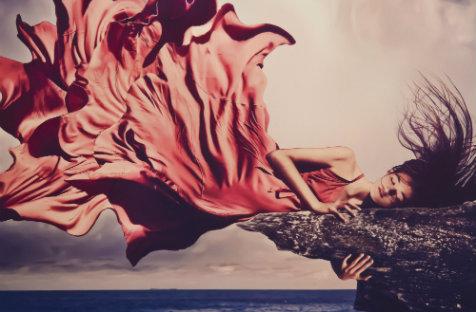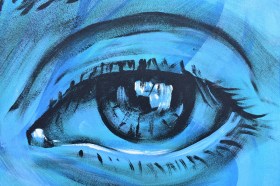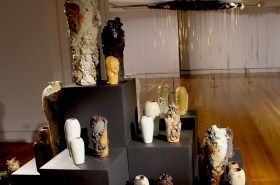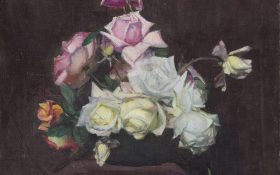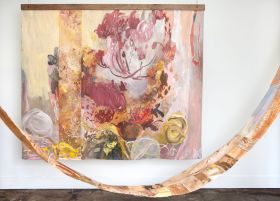Marking its 30th anniversary, the ARTEXPRESS 2013 exhibition at the Art Gallery of NSW features 42 works from the 2012 crop of NSW HSC Visual Arts students. As an annual fixture, Artexpress may suffer the repercussions of its permanence, the long acquaintance stealing away the excitement. As in all relationships, one must allow oneself to be surprised.
Artexpress 2013 is a gem, a wonderful window into the upcoming generation of Australian artists, an insight into Australian adolescents at the brink of adulthood, and finally, a mirror to ourselves, as they see it; the world which exists outside of them, and which they are about to enter.
The students are expected to ‘create bodies of work that represent their intensions as artists’. In a number of works, the expression of artistic intent is interpreted as a social commentary.
The show opens with Josie Stevens’ Social Tapestry, a post-modern interpretation, it states, of the Bayeaux Tapestry. The work is a depiction of historical events, painted in monochromatic tones with flashes of colour. The composition is a timeline, or rather a series of stratums, with a row reserved for images of exposed ribs. Stevens notes Picasso’s Guernica as one of her key influences.
A more developed response, perhaps, is the audio-visual feast, My Blanket by Allara La Ferla. La Ferla is also the recipient of the Television of Sydney (TVS) Digital Media Award. La Ferla’s work concerns itself with the Stolen Generation. The interplay of felt woven into nests, pitchers and ‘blankets’ is delicate and moving, as is the texture of women’s voices, intertwined in the recounting of their memories: the cadence of their speech, rising and falling against the soft structures. The execution is clear and elegant, and above all, arresting without imposing itself upon the viewer.
India Gates’ Conscience Vote is playful and reflective of its generation. Gates combines acrylic painting with digital media to recreate and reinterpret classic paintings: Jan van Eyck’s Arnolfini Portrait, Jean-Honoré Fragonard’s The Swing and Jean Gossaert’s Adam and Eve. The models’ body language is exquisite. There is a great deal of humour in these, notably Adam and Eve re-cast as young men against the Tree of Knowledge, complete with the ill-fated iPhone and earphones snaking around Eve’s low cut jeans and exposed boxer shorts. Delightful and yet, simultaneously, reframing questions about knowledge, youth, seduction, temptation, eviction from paradise, performance of sexuality and sex, and the family.
Alexis O’Connor’s After Leonardo raises ‘concerns about humanity’s dependence of technology’. O’Connor sets human organs against the machine: lungs, head, stomach, ear; in pen on ink dyed paper, reminiscent of Da Vinci’s drawings. There is a taste of the cerebral, and some of the artworks, while well executed, remain too close to thought.
Dana Segall’s series of prints and structures, Slum Dwellers, while painstakingly executed, remains on the surface.
An Altered Environment by Edward Dooley positions itself against the impact of built environment on the natural environment. Dooley states: ‘My work combines the post-modern mediums of installation, photography and found object sculpture to explore the destructive impact humans have on nature.’ While the process and the resulting image creations are interesting, they tend to wash over the viewer and vanish soon after. The question is, whether the theory, or the process, imposed itself upon the artist and hijacked the artwork.
Besides the educational formalities, the HSC also marks a certain point of departure in a young person’s life. Some of the student works explore the nature of this liminal phase, the anxieties associated with it, and the break from the fable elements of childhood. Bronte Lloyd’s Anx.i.e.ty presents a very tender and thoughtful exploration of the emotional life; Jonah Beard’s Puer Aeternus; Eternal Child looks into what role one’s childhood plays when one is no longer a child. Beard’s application of mixed media on wood board is well handled, supporting the expression and not dominating the work.
Adolescence would not be what it is without sleep, and excess of sleep. Moshe Uhrig’s Hypnagogia is an exploration of lucid dreaming, a ‘state usually passive and uncontrolled’, Uhrig says, expressing a sense of ‘entanglement’ and ‘entrapment’, through the intricate pen and lithographic prints of twining hair, and tentacles. Uhrig’s work is evocative of Albrecht Dürer, and creates a sense of dark hypnotic dreamlands.
Dreamlands appear in Natasha Capstick’s Time Before Times. Capstick’s work is visually beautiful, and suggestive of fashion and fantasy imagery. As per Gates’ work, Capstick’s imagery brings forth questions about femininity, with the symbolism of the foam, seaside, young women holding onto rocks, akin to Greek sacrificial maidens. The exhibition’s chosen advertising image reminds of Boticcelli’s Birth of Venus. Capstick is very popular with the visitors, so it may require a return when viewers disperse.
And finally, for the beauty and the humour of Laura Payne’s gargoyles in the Inveniret Libertatem, and Francesca Fox’s Vadallat, crochet and knitted ‘wild animal’ heads Fox mounts as trophies and gets her family to wear for a family portrait.
There are beautiful moments, and there are many; all of them bringing forth something of themselves, and their future.
The Gallery provides extensive online resources, which include student notes, references and process diaries. Many of the resources are available for download for those who wish to explore further.
ARTEXPRESS 2013
Art Gallery of New South Wales, Sydney
20 February – 14 April
